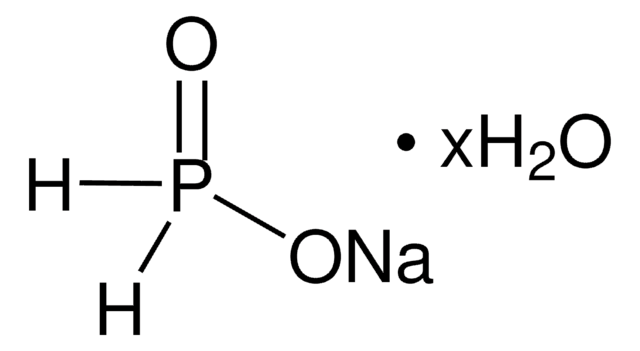04434
Sodium hypophosphite
puriss., meets analytical specification of BPC63, anhydrous, 98-101%
About This Item
Produits recommandés
Qualité
puriss.
meets analytical specification of BPC63
Pureté
98-101%
Forme
powder or crystals
Impuretés
≤0.001% heavy metals (as Pb)
≤0.2% free alkali (as CaO)
Perte
≤1% loss on drying, 105 °C, 2 h
Solubilité
water: soluble 909 g/L at 30 °C
Densité
1.77 g/cm3 at 20 °C
Traces d'anions
chloride (Cl-): ≤200 mg/kg
sulfate (SO42-): ≤200 mg/kg
Traces de cations
As: ≤2 mg/kg
Fe: ≤10 mg/kg
Chaîne SMILES
[Na+].[O-][PH2]=O
InChI
1S/Na.H3O2P/c;1-3-2/h;3H2,(H,1,2)/q+1;/p-1
Clé InChI
SIGUVTURIMRFDD-UHFFFAOYSA-M
Vous recherchez des produits similaires ? Visite Guide de comparaison des produits
Catégories apparentées
Description générale
Application
- Synthesis and characterization of chitosan-copper nanocomposites and their catalytic properties for 4-nitrophenol reduction.: This study explores the synthesis of chitosan-copper nanocomposites using sodium hypophosphite as a reducing agent. The resulting nanocomposites are characterized and their catalytic properties for the reduction of 4-nitrophenol are evaluated, demonstrating the utility of sodium hypophosphite in catalytic applications (Pang et al., 2024).
- The Durable Chitosan Functionalization of Cellulosic Fabrics.: This research focuses on the durable functionalization of cellulosic fabrics with chitosan using sodium hypophosphite as a cross-linking agent. The study highlights the improved properties of the fabrics, showcasing sodium hypophosphite′s role in textile enhancement (Flinčec Grgac et al., 2023).
- Hypophosphite cross-linked starch succinate/chitosan membranes as alternative for packaging and pharmaceutical application.: The study investigates the development of starch succinate/chitosan membranes cross-linked with sodium hypophosphite, proposing these materials as potential alternatives for packaging and pharmaceutical applications (Bajer, 2023).
- Tensile Strength Improvements of Ramie Fiber Threads through Combination of Citric Acid and Sodium Hypophosphite Cross-Linking.: This research improves the tensile strength of ramie fiber threads by combining citric acid and sodium hypophosphite for cross-linking, demonstrating significant enhancements in fiber properties for industrial applications (Wulandari et al., 2023).
- Nickel-Catalyzed Sodium Hypophosphite-Participated Direct Hydrophosphonylation of Alkyne toward H-Phosphinates.: This study demonstrates a novel nickel-catalyzed hydrophosphonylation of alkynes using sodium hypophosphite. The research showcases the efficiency of sodium hypophosphite in producing H-phosphinates, highlighting its significance in chemical synthesis (Qian et al., 2023).
Code de la classe de stockage
13 - Non Combustible Solids
Classe de danger pour l'eau (WGK)
WGK 2
Point d'éclair (°F)
Not applicable
Point d'éclair (°C)
Not applicable
Certificats d'analyse (COA)
Recherchez un Certificats d'analyse (COA) en saisissant le numéro de lot du produit. Les numéros de lot figurent sur l'étiquette du produit après les mots "Lot" ou "Batch".
Déjà en possession de ce produit ?
Retrouvez la documentation relative aux produits que vous avez récemment achetés dans la Bibliothèque de documents.
Les clients ont également consulté
Notre équipe de scientifiques dispose d'une expérience dans tous les secteurs de la recherche, notamment en sciences de la vie, science des matériaux, synthèse chimique, chromatographie, analyse et dans de nombreux autres domaines..
Contacter notre Service technique










